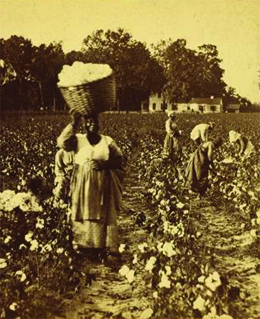| << Chapter < Page | Chapter >> Page > |
The slaves who built this cotton kingdom with their labor started by clearing the land. Although the Jeffersonian vision of the settlement of new U.S. territories entailed white yeoman farmers single-handedly carving out small independent farms, the reality proved quite different. Entire old-growth forests and cypress swamps fell to the axe as slaves labored to strip the vegetation to make way for cotton. With the land cleared, slaves readied the earth by plowing and planting. To ambitious white planters, the extent of new land available for cotton production seemed almost limitless, and many planters simply leapfrogged from one area to the next, abandoning their fields every ten to fifteen years after the soil became exhausted. Theirs was a world of mobility and restlessness, a constant search for the next area to grow the valuable crop. Slaves composed the vanguard of this American expansion to the West.
Cotton planting took place in March and April, when slaves planted seeds in rows around three to five feet apart. Over the next several months, from April to August, they carefully tended the plants. Weeding the cotton rows took significant energy and time. In August, after the cotton plants had flowered and the flowers had begun to give way to cotton bolls (the seed-bearing capsule that contains the cotton fiber), all the plantation’s slaves—men, women, and children—worked together to pick the crop ( [link] ). On each day of cotton picking, slaves went to the fields with sacks, which they would fill as many times as they could. The effort was laborious, and a white “driver” employed the lash to make slaves work as quickly as possible.

Cotton planters projected the amount of cotton they could harvest based on the number of slaves under their control. In general, planters expected a good “hand,” or slave, to work ten acres of land and pick two hundred pounds of cotton a day. An overseer or master measured each individual slave’s daily yield. Great pressure existed to meet the expected daily amount, and some masters whipped slaves who picked less than expected.
Cotton picking occurred as many as seven times a season as the plant grew and continued to produce bolls through the fall and early winter. During the picking season, slaves worked from sunrise to sunset with a ten-minute break at lunch; many slaveholders tended to give them little to eat, since spending on food would cut into their profits. Other slaveholders knew that feeding slaves could increase productivity and therefore provided what they thought would help ensure a profitable crop. The slaves’ day didn’t end after they picked the cotton; once they had brought it to the gin house to be weighed, they then had to care for the animals and perform other chores. Indeed, slaves often maintained their own gardens and livestock, which they tended after working the cotton fields, in order to supplement their supply of food.

Notification Switch
Would you like to follow the 'U.s. history' conversation and receive update notifications?